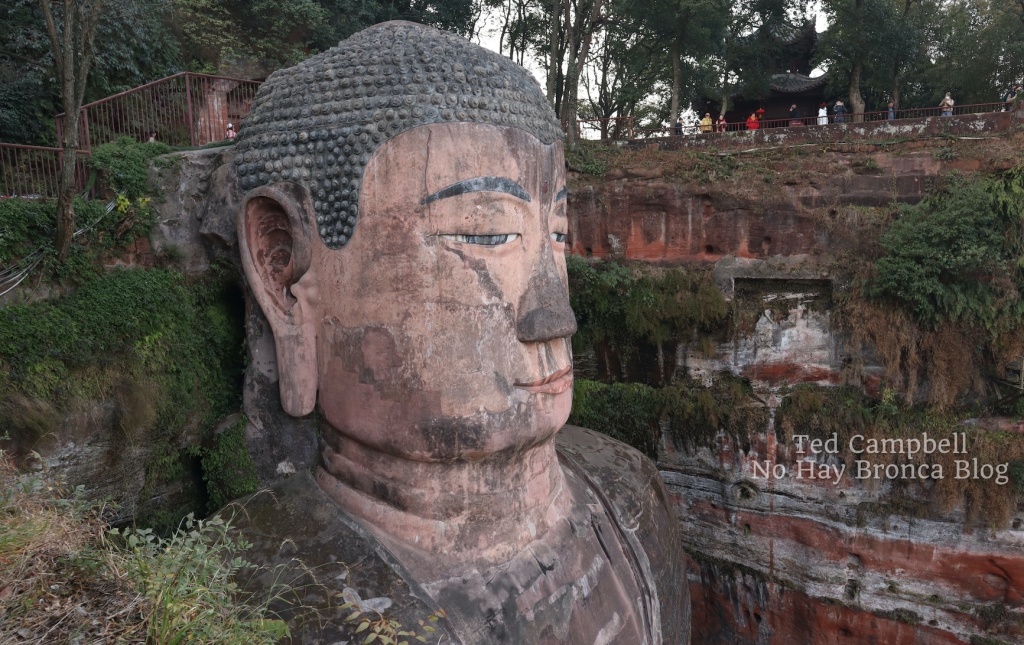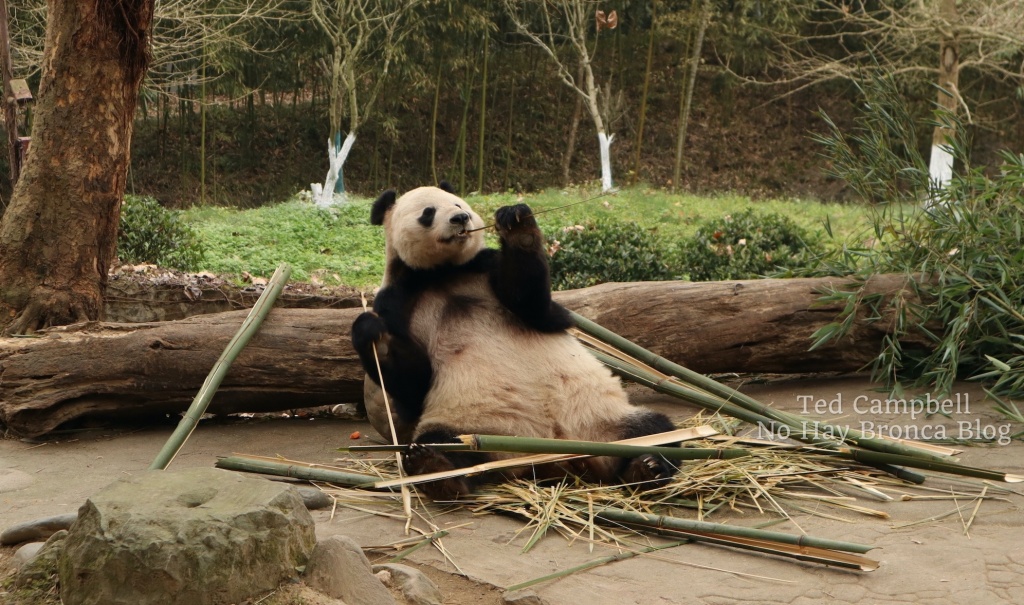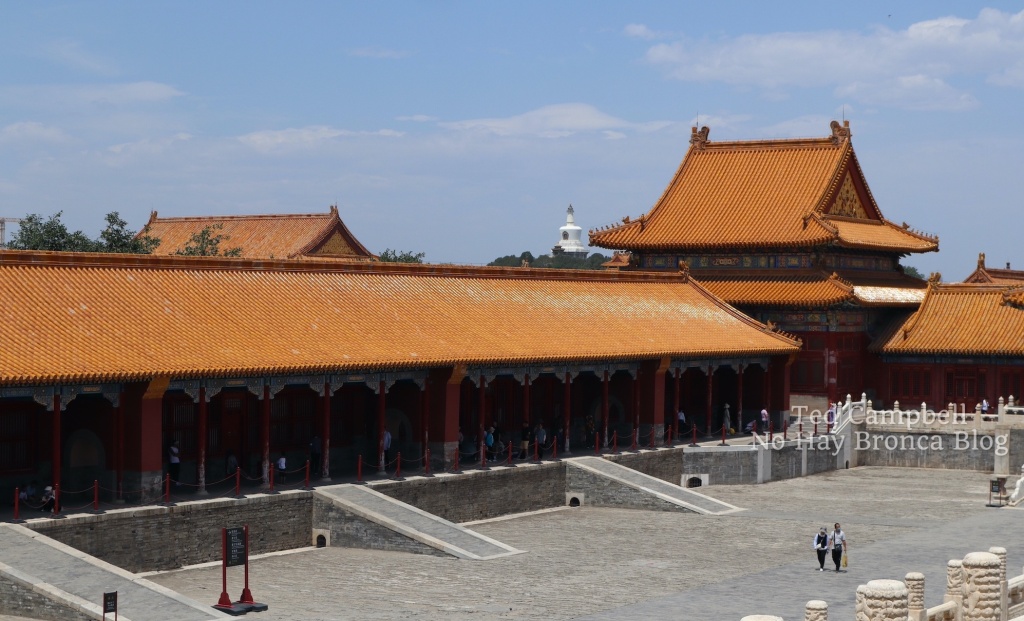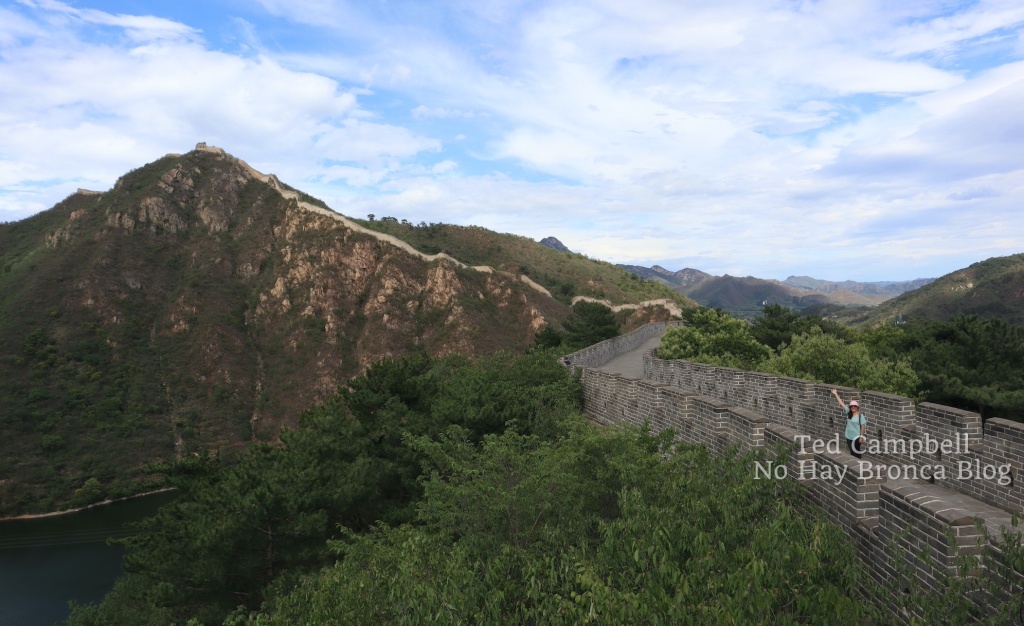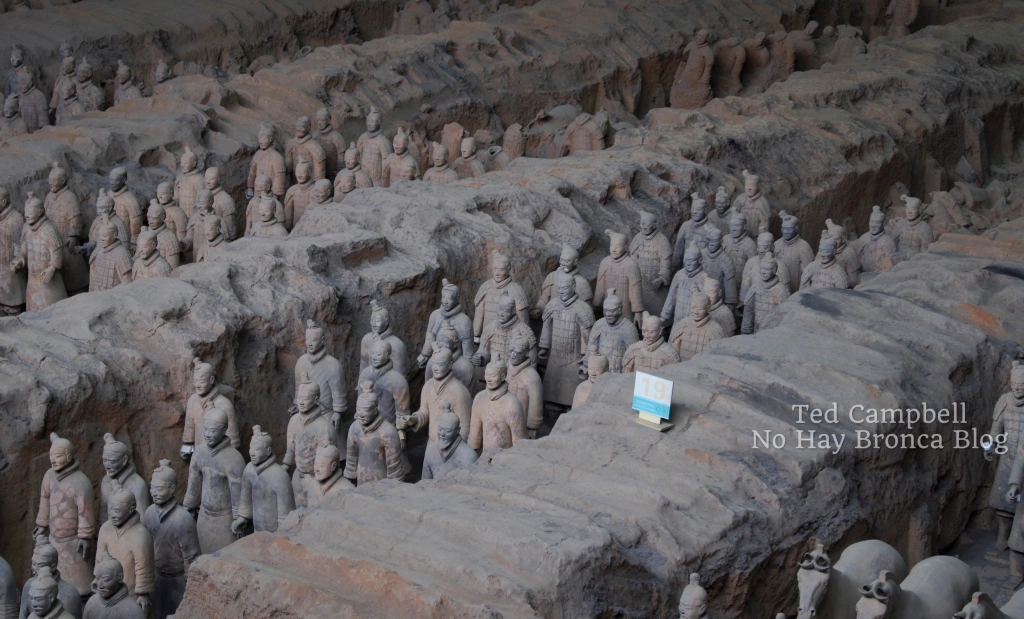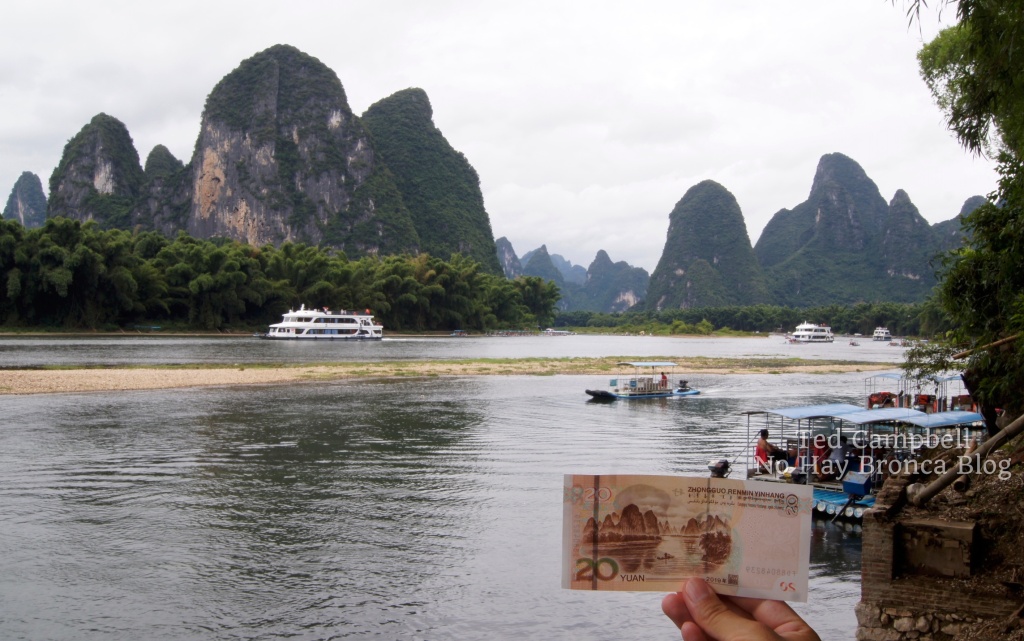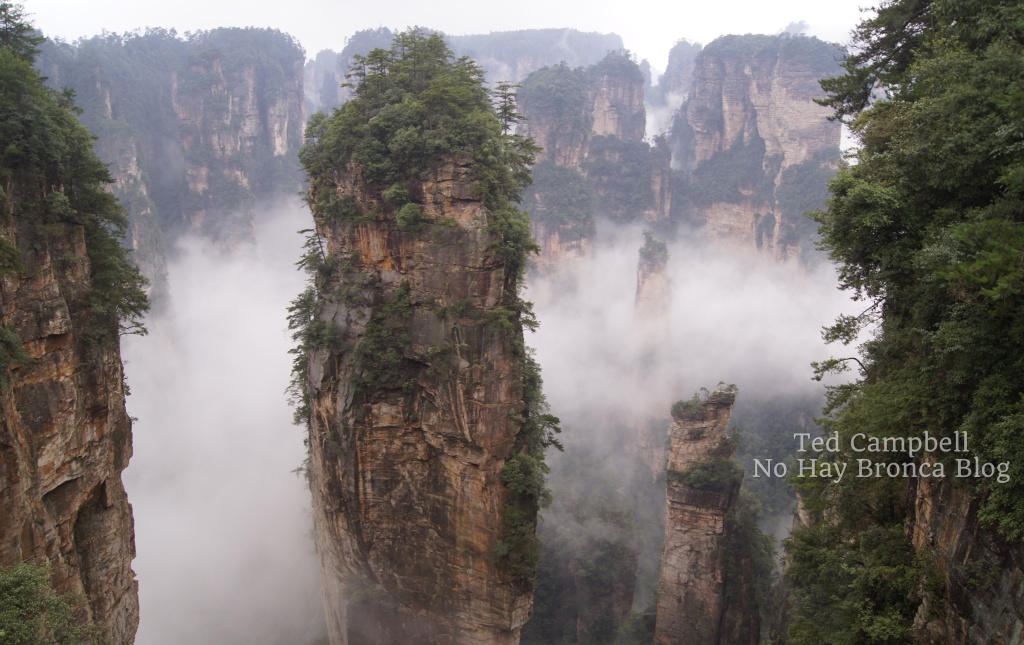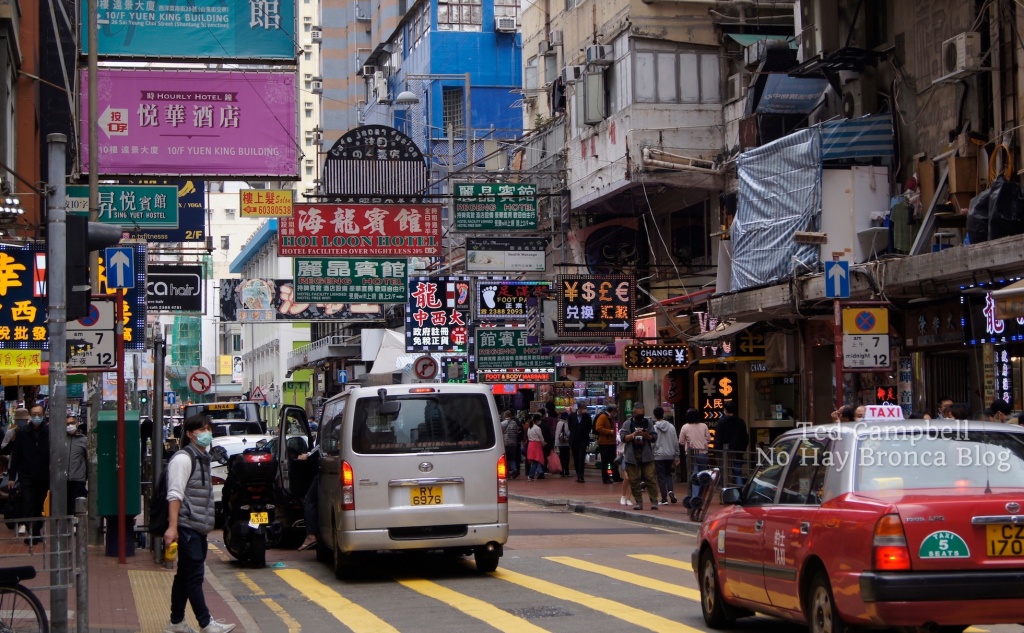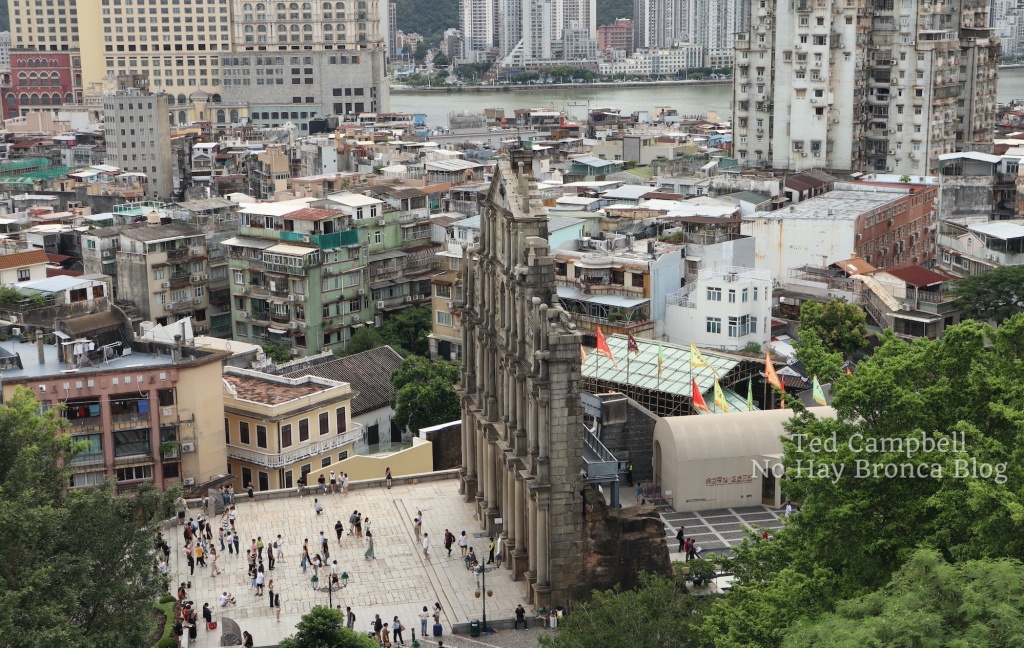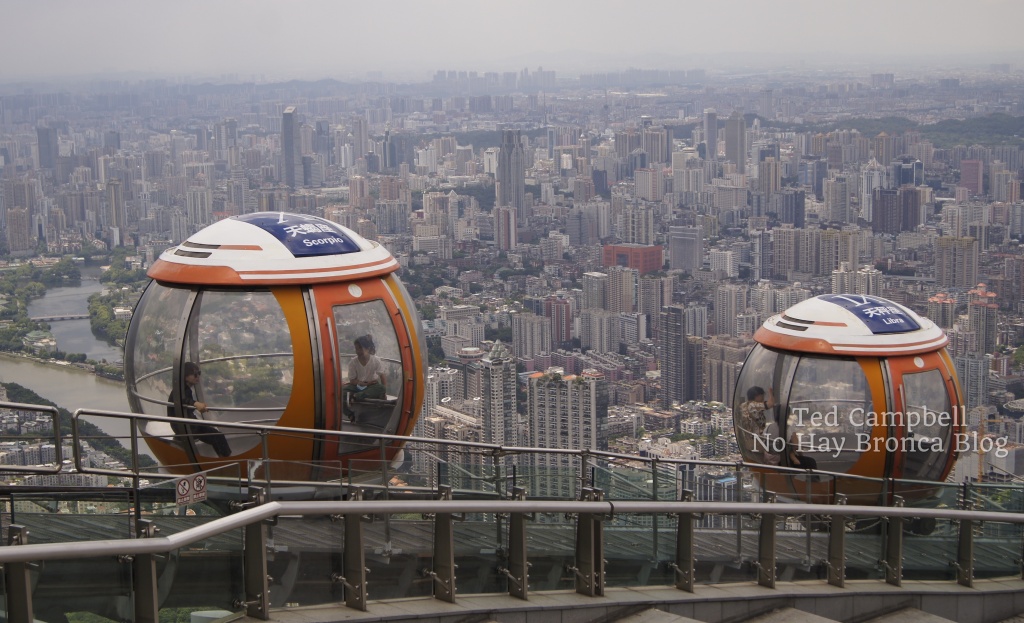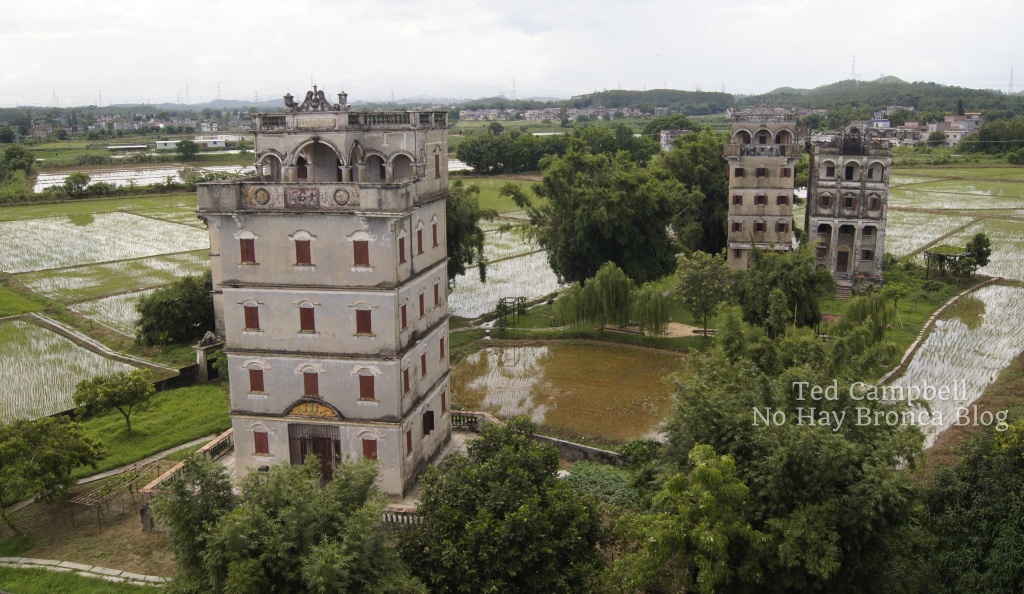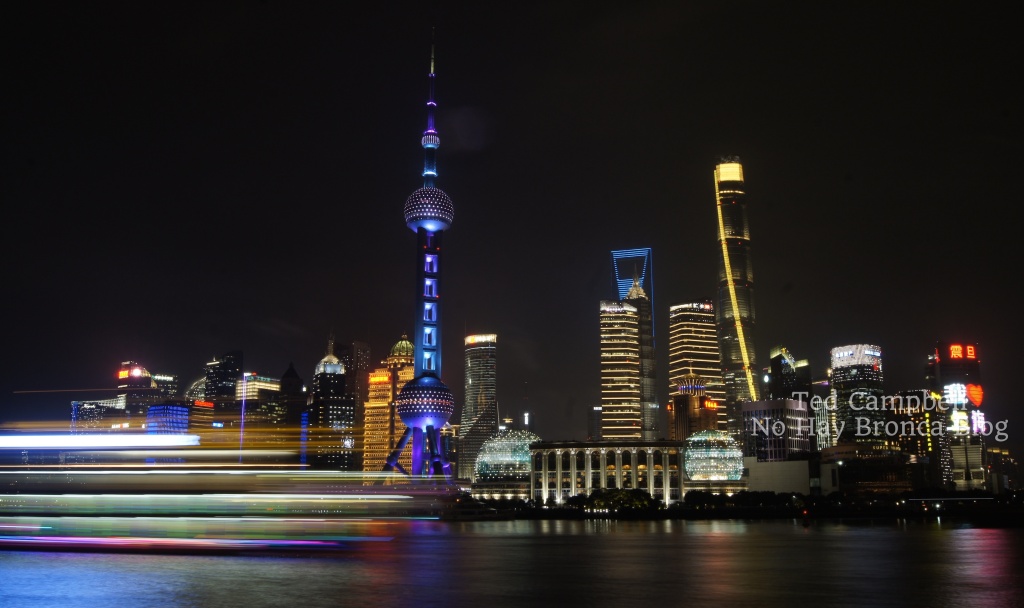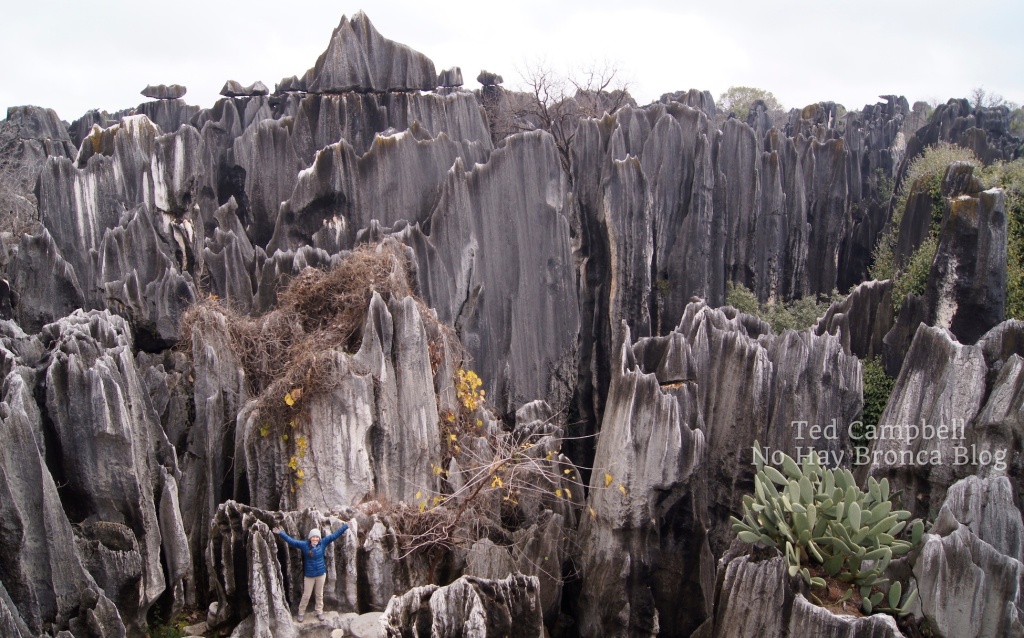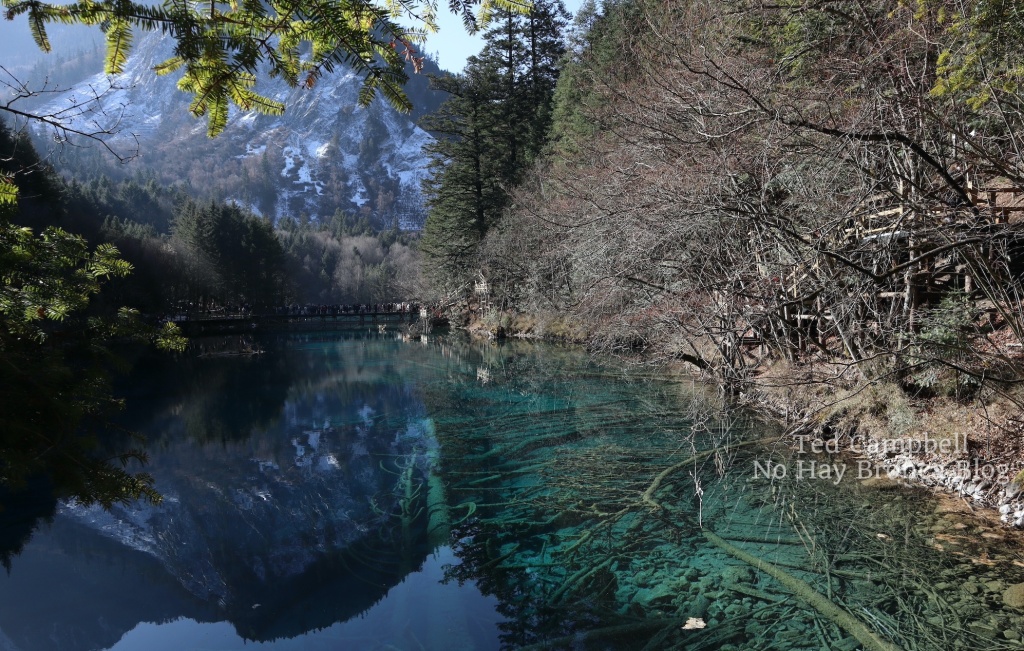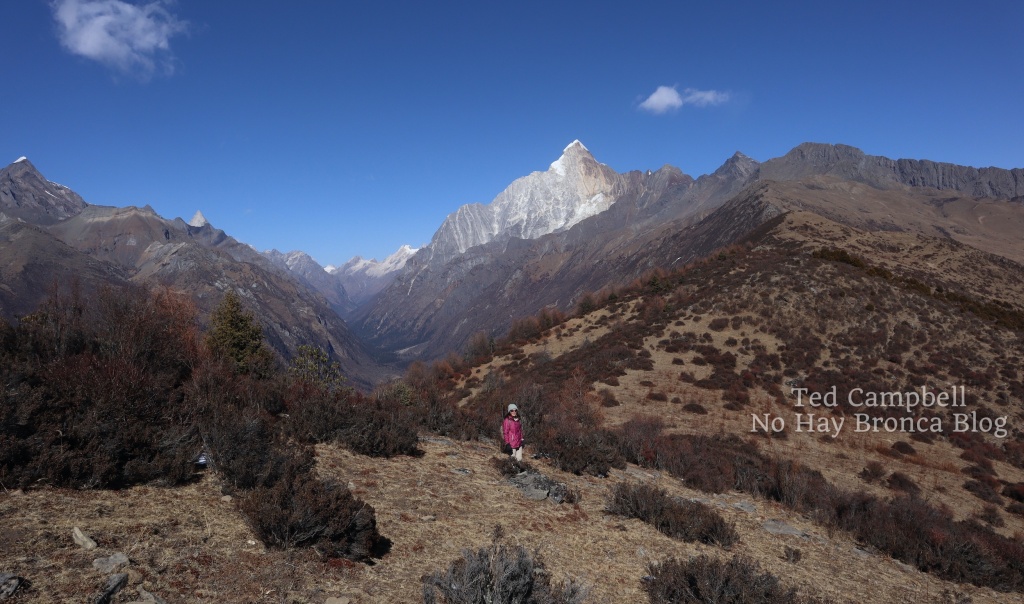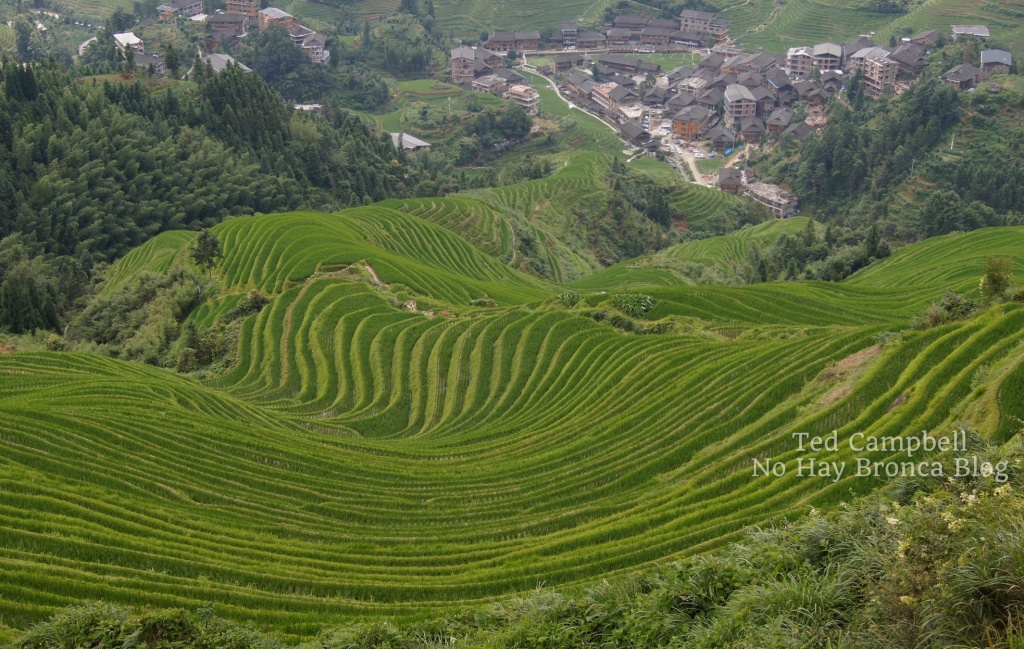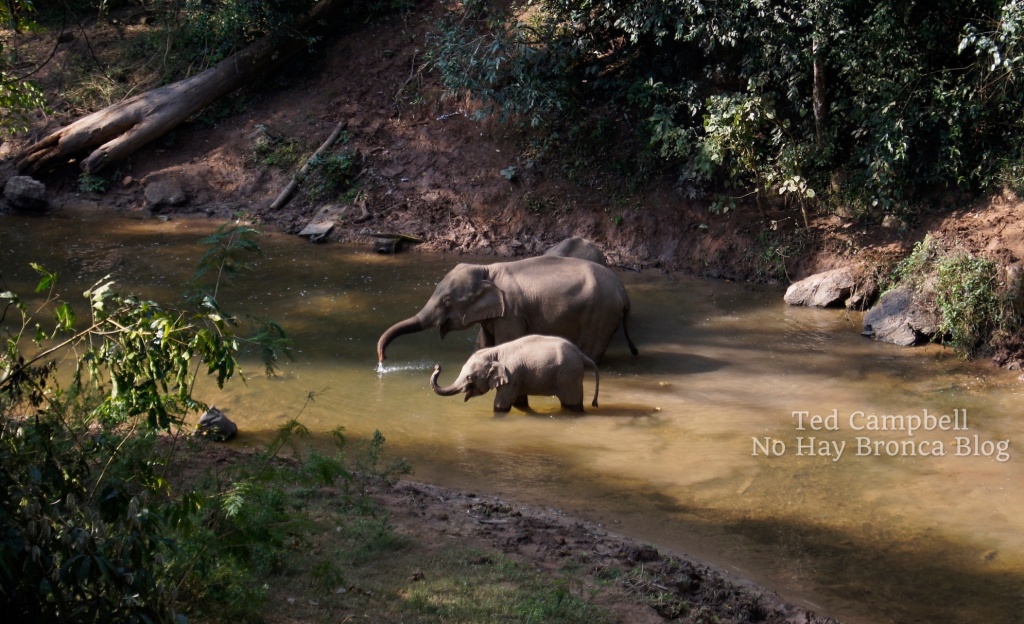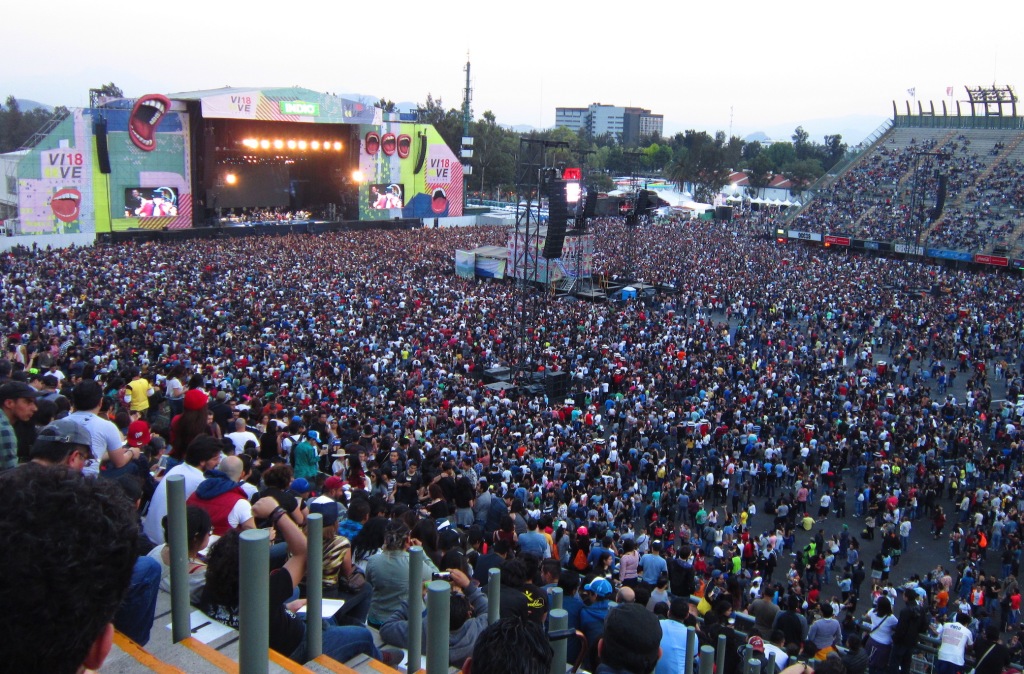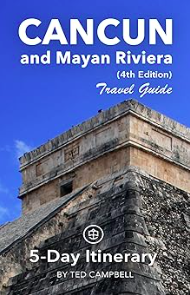The Monarch Butterfly Migration to Mexico
The North American monarch butterfly migration is one of the largest in the world. Every year millions of monarch butterflies head to the same relatively small area in central Mexico.
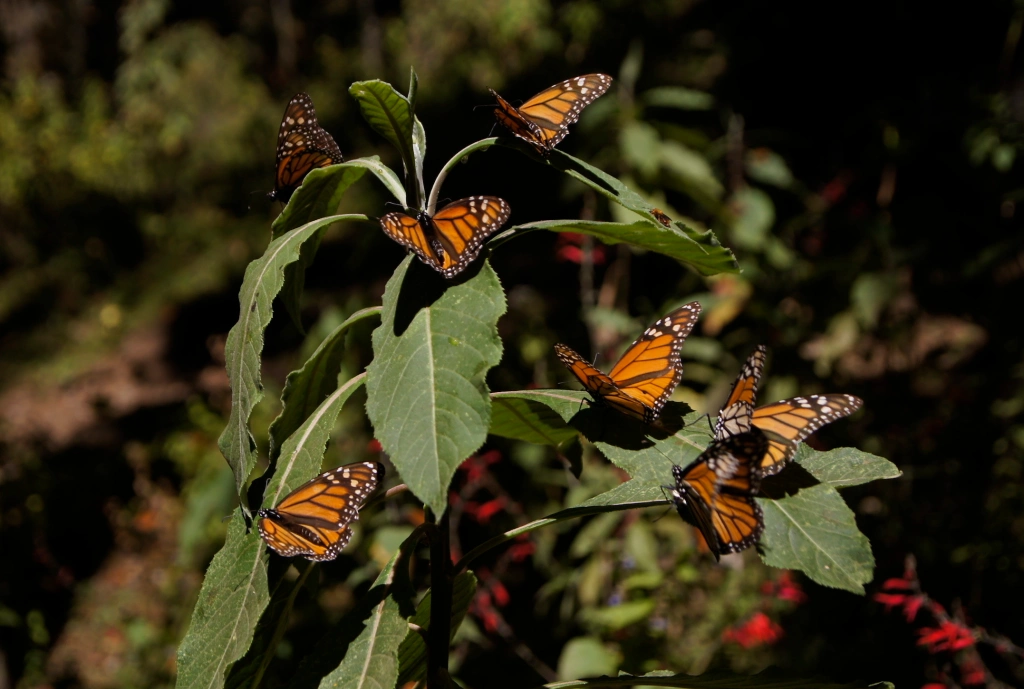
If I told you that, every year, millions of insects migrate thousands of miles from the eastern U.S. and Canada to the same part of central Mexico, would you want to go there to see them? Probably not, if you’re imagining roaches or locusts or something similarly horrible.
Fortunately, the protagonist of this voyage is the monarch butterfly, pleasant creatures to walk among as they gather in great groups on the trunks of tall oyamel fir trees in the mountain forests of Michoacan and the State of Mexico.
The monarch butterfly migration is one of the largest in the world, certainly the largest in North America, and the only one by insects that includes the return trip. And it happens right above our heads every year—millions of butterflies following no leader but instinct.
Or is it something more than instinct? It’s still a mystery to scientists how these masses of butterflies return to the same specific areas every year, a relatively small region of the central Mexican plateau that’s about a four-hour drive from Mexico City.
Although the precise method is unknown—it may have to do with Earth’s magnetic field, the wind currents of the northern hemisphere, or some kind of insect collective unconscious, the purpose is clear.
The monarch butterflies migrate to escape the cold winters of the north, which they’re far too sensitive to survive, for the perpetual spring weather of the Mexican highlands, like so many other northern visitors.
Much of the Mexican altiplano is arid and desert-like, but the areas around its mountain ranges have forest groves with enough humidity to support the needs of countless creatures, including the monarch butterfly.
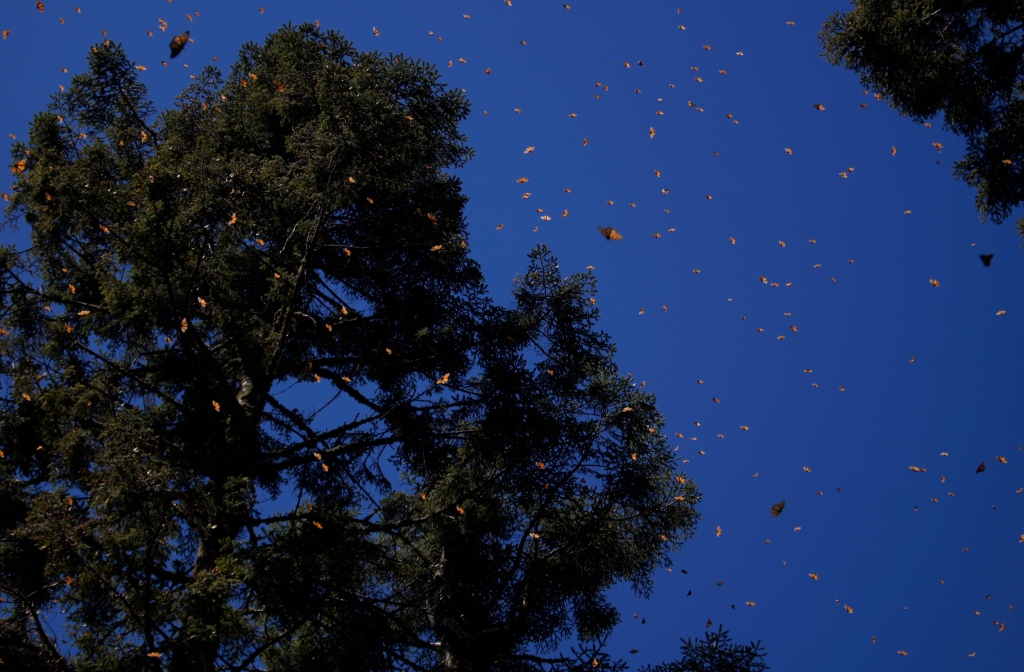
Another mysterious phenomenon is involved in the monarch butterfly migration: the birth of a special generation that lives much longer than the average butterfly. Most monarchs live only a few weeks, but in late summer, the migratory generation is born, the final generation of the year.
Also called the Methusula generation, named after the biblical character who lived 969 years, these butterflies have a lifespan of up to nine months, allowing them to migrate south to Mexico, gather together in the trees for warmth and protection, breed and produce the next generation.
These successive generations have the typical two-to-five-week lifespan, so they fly north in stages, laying eggs and dying along the way. About four generations later, once the voyage is over, the migratory generation is born once again, destined to travel south like their great-great-great grandparents did the year before.
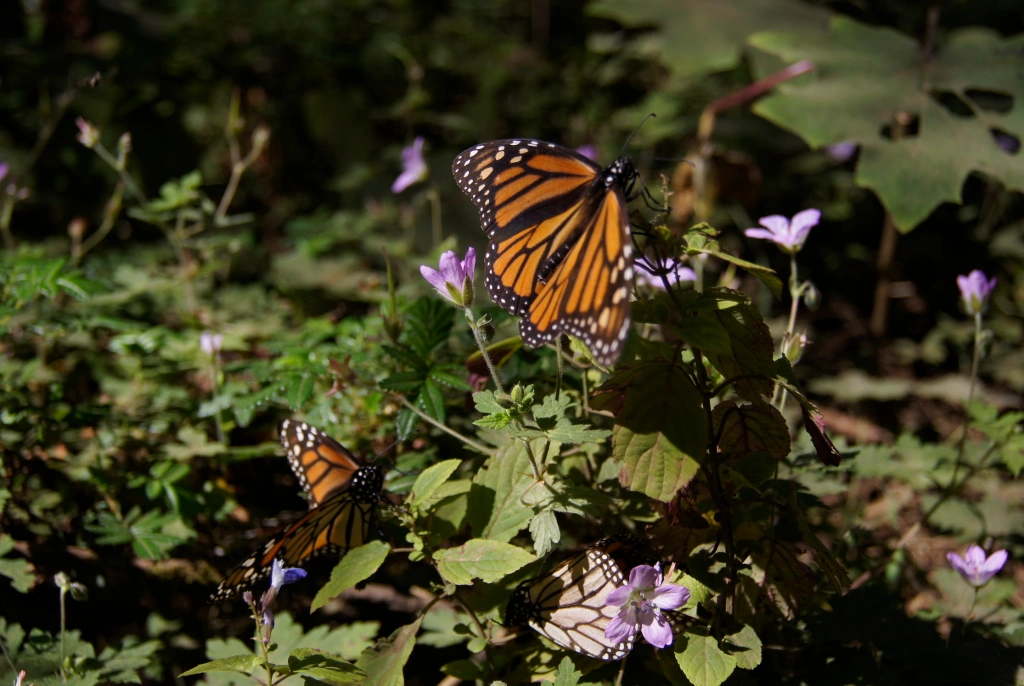
These insects face plenty of obstacles on the way, in both the north and south. For instance, according to the Washington Post, 20 million monarch butterflies die every year from getting hit by cars.
In the U.S. and Canada, the main threat comes from a decline in milkweed, which the butterflies rely on for food. More factory farms and fewer milkweed plants means less food for the monarchs. The butterflies also face danger from the weather—one harsh chill on the way, and an entire flock can be wiped out.
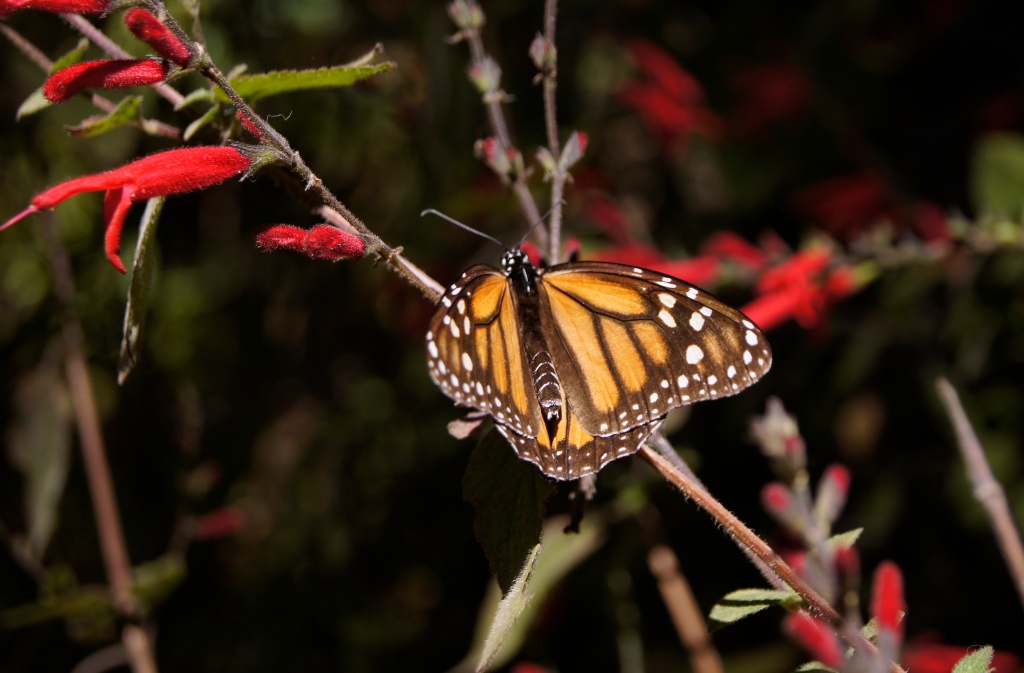
In Mexico, the greatest threat comes from habitat loss, especially logging, which is why the Mexican government has designated eight butterfly sanctuaries. Five are open for limited tourism. You must stay on designated trails, and touching the butterflies is forbidden.
Besides being important sources of food for creatures higher on the food chain, monarch butterflies are important pollinators, like bees. Therefore, conservation efforts are underway in both countries.
The fate of the monarch butterfly migration is such an important issue that it was a topic of discussion during a summit of North American leaders Barack Obama, Peña Nieto and Stephen Harper in 2014 in Toluca, the nearest big city to the sanctuaries. Afterwards, Michelle Obama planted milkweed and other plants favored by the monarch butterfly at the White House.
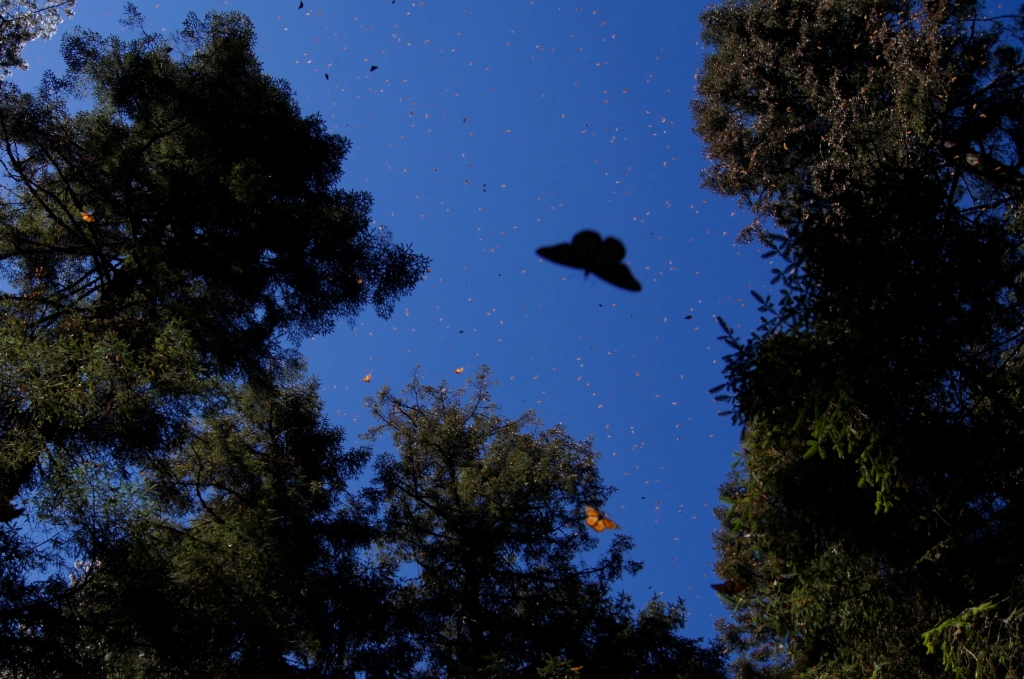
I visited the largest monarch butterfly sanctuary in Mexico, El Rosario, in March of 2019. We left early from Toluca, the capital of the State of Mexico, taking the highway west to the state of Michoacan.
More remote parts of Michoacan have a bad reputation for danger from drug gangs, but there’s little to worry about on this well-worn route between the monarch butterfly reserves and Mexico City. (Toluca is on the way.)
Two hours into the drive, as we grew closer to the El Rosario monarch butterfly sanctuary, a few fluttered on the side of the twisting road, but nothing like the dense clouds we hoped to see.
No matter, we pressed on, and after about three hours on a smooth highway surrounded by low brown hills, patches of rolling forest, and small concrete towns, we reached the parking lot for El Rosario.
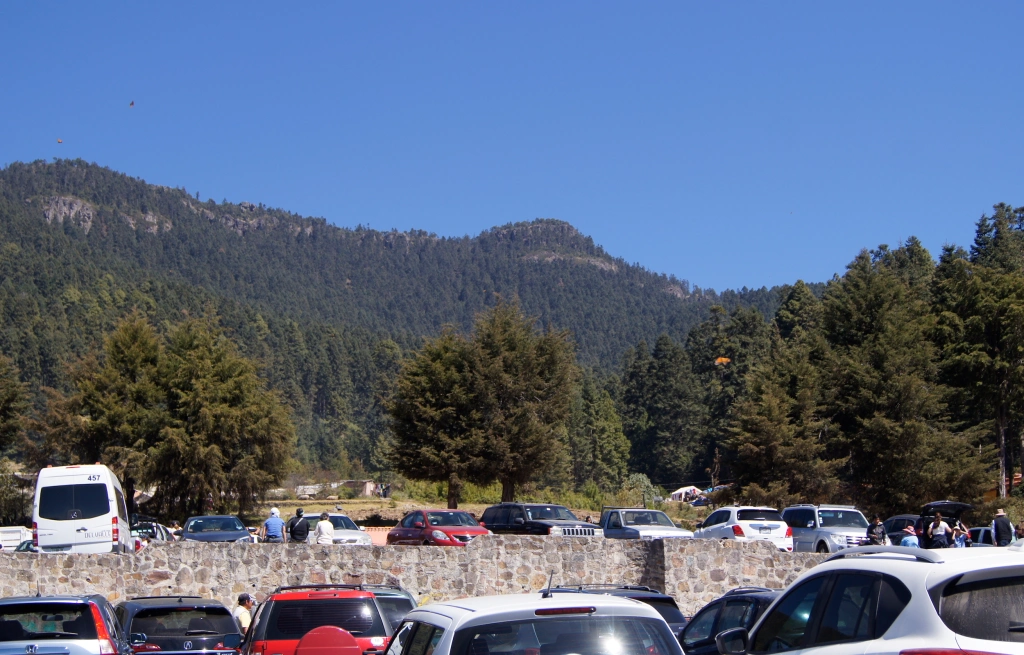
To enter the monarch butterfly sanctuary, first there was an uphill walk on a twisting path lined with wooden structures containing small restaurants and vendors, most selling butterfly-related souvenirs: painted ceramic decorations, tablecloths, and t-shirts, all decorated with the familiar orange and black pattern.
Many had buckets of fresh fruit for sale, including peaches, strawberries, and blackberries bigger your thumb. Smoke poured from open grills in front of the restaurants, while teenagers holding laminated menus called out the specialties of each.
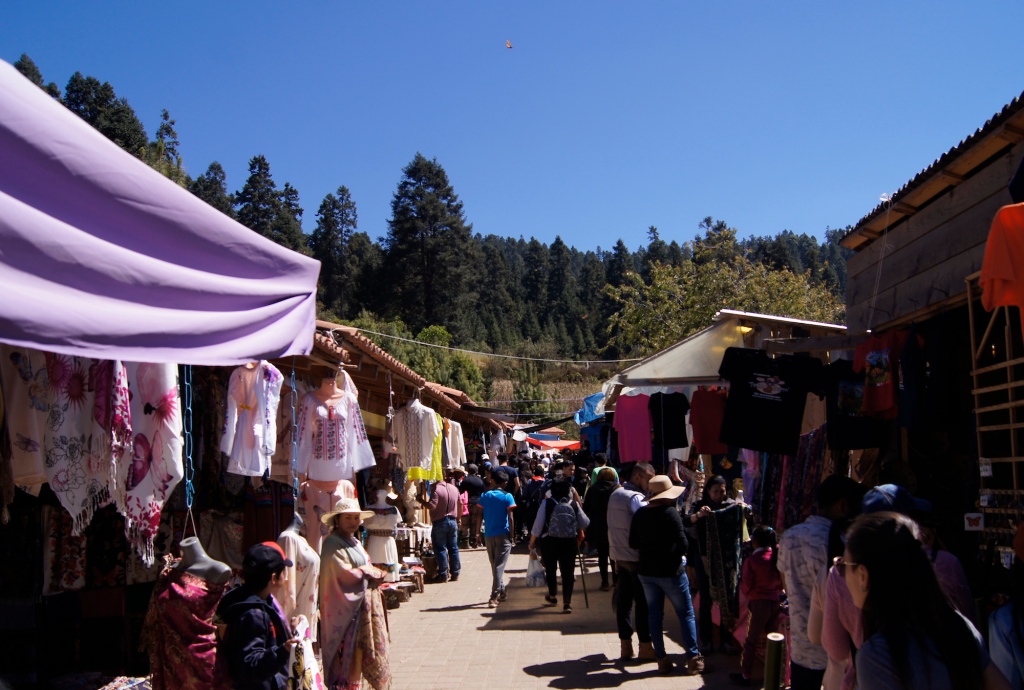
The entrance to the monarch butterfly sanctuary appeared after this gauntlet, a wide arch above the crowds. By now the butterflies were thick in the air. We paid the 50-peso entrance fee (about $2.50 USD) and entered El Rosario.
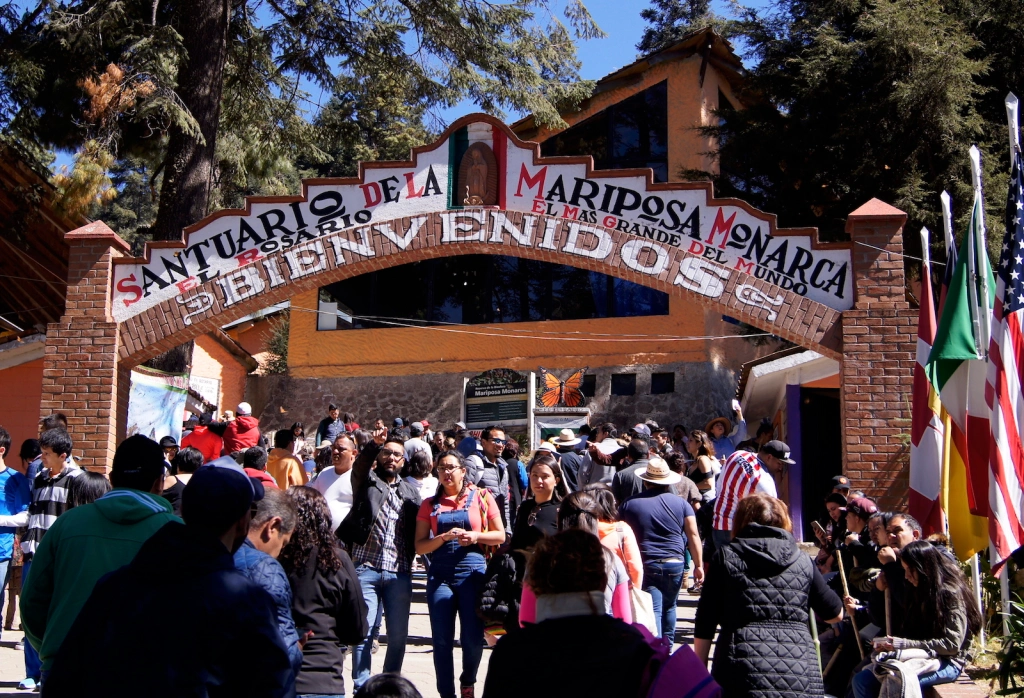
One long trail in a big loop went up and then down the mountain slope among the tall oyamel fir trees. A few other trails branched off from this loop, but they were either blocked off or for horses only. According to the guides selling horse rides, the butterflies were even thicker higher in the mountains and away from the crowds.
Some tree trunks were completely covered in butterflies, fluttering masses that resembled the leaves of dense creeper ivy in black and orange. The sky was full of them, the ground too, though mostly with corpses of the fallen. We passed several pools of muddy water where butterflies drank on the surface and from all sides.
The path took about two hours with slow walking and lots of stopping for pictures or to just take in the spectacle. With continuous walking, it would take about an hour. I couldn’t help but think that any other insect swarm might not be so pleasant, but the colorful butterflies instead made for a peaceful, beautiful sight. The light sound of fluttering wings was like a breeze through stiff leaves.
For the most part the butterflies stayed well above our heads, although regularly one or two would drift down to land on a shoulder or forearm. One of the park’s rules was to not touch any butterflies, and it seemed well respected for the most part. You had to watch your step as well, because many butterflies ended up landing on the path.
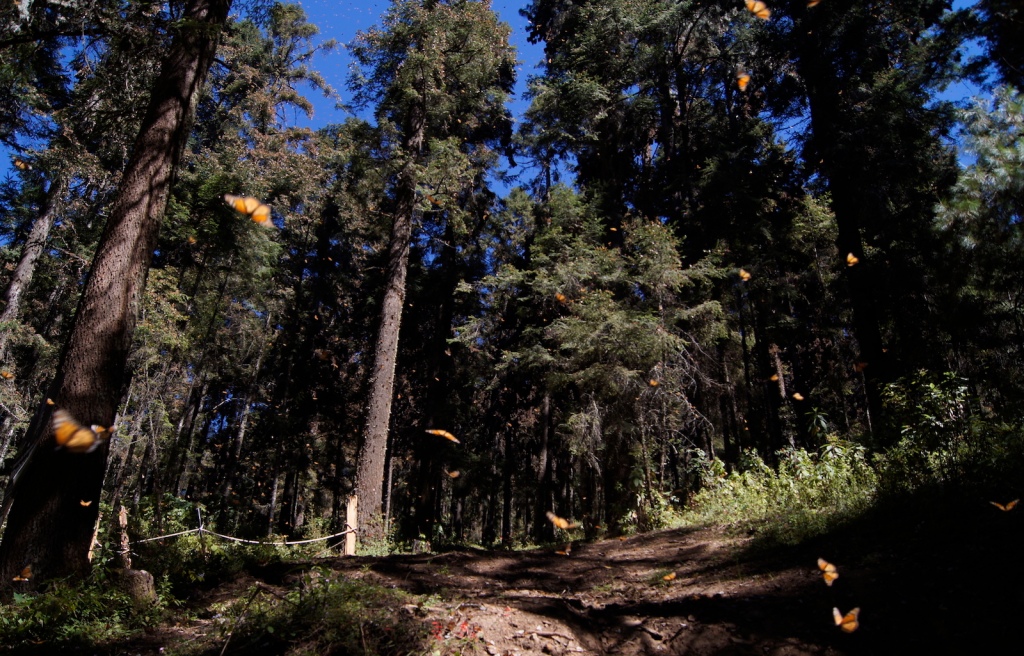
Once we left the park, we took a different route home, on narrow highways through the forested mountains of Michoacan to the magic town of El Oro, which translates to The Gold.
El Oro used to be a gold mining community that attracted prospectors from all over the world, especially from English companies, which is reflected today with names like Brockman for a large reservoir next to the town. Buildings like the Municipal Palace and the Juarez Theatre have art nouveau and neoclassical architecture that you don’t usually see in Mexican small towns, which are typically in the Spanish colonial style.
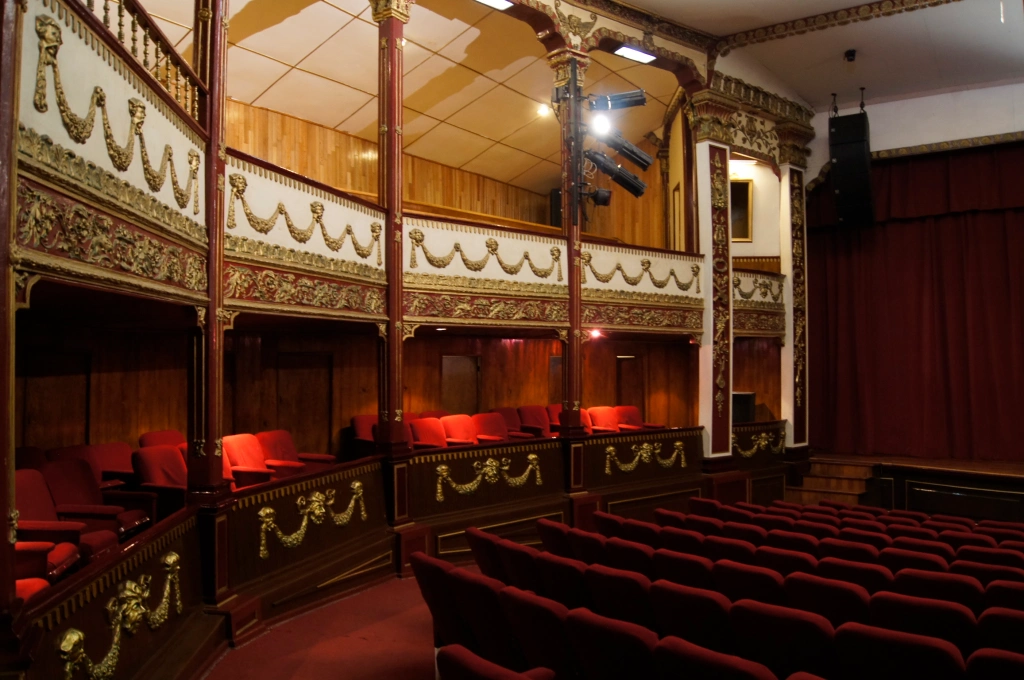
We ate lunch in the Vagon Express Minero restaurant inside an old converted train car in the center of town. When someone stood up or a waitress walked by, the whole car rocked back and forth with the motion. The food was ok; the atmosphere better.

I’d already been to Tlapujajua, another magic town just up the road, but never to El Oro itself. Both are nice and quite different—Tlapujajua is all winding cobblestone streets on the side of a mountain slope, while El Oro is relatively flat and laid out in a grid. Visiting both in one day would be easy, and would give a nice introduction to the tranquil, friendly Mexican magic towns.
The magic town designation is a program in Mexico to recognize and preserve the most beautiful and representative small towns in the country. At the moment there are 121. I’ve been to many—maybe 40 or 50—and each has something unique or interesting.
In El Oro, it’s certainly the ambiance, with qualities not seen elsewhere in Mexico—British names and wooden buildings, a train car restaurant, and an old train station across the street that’s now a museum. Besides the Tequila trains that leave from Guadalajara and the Copper Canyon train in the north, there are no passenger trains in Mexico, so these are rare sights.
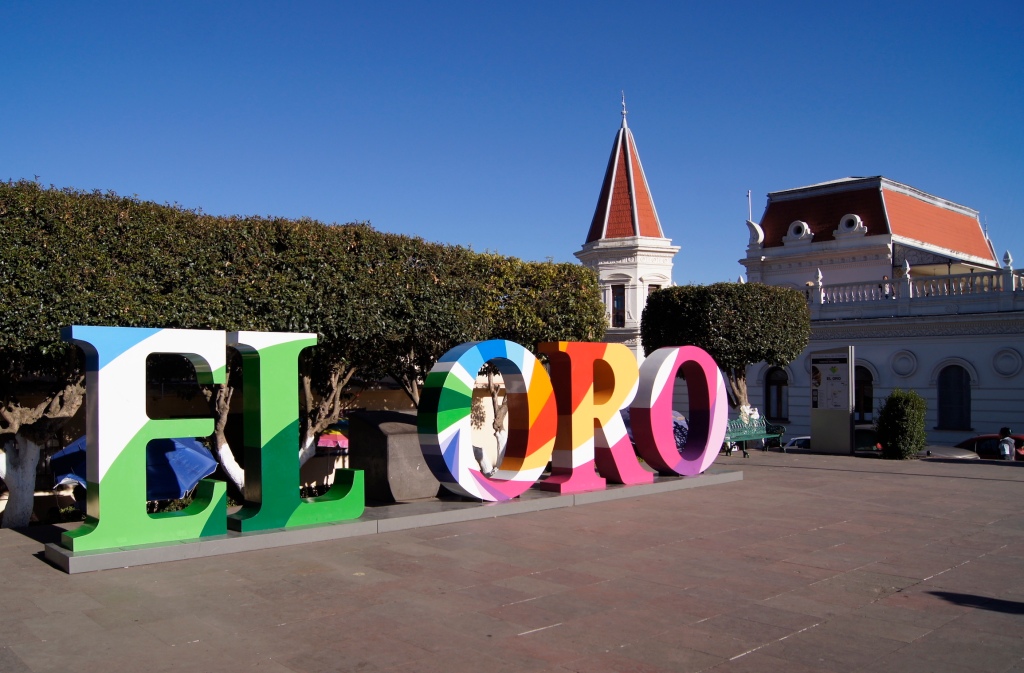
Another good stop near the butterfly sanctuaries is Valle de Bravo in the State of Mexico, which is in the opposite direction from El Oro and Tlapujajua. With its large reservoir for boat rides, tall mountains for parasailing or mountain biking, and pretty town center, Valle de Bravo is a popular weekend destination for people living in the madness of Mexico City.
If you wanted to spend more than one day on your butterfly adventure, a small hotel in Valle de Bravo would be your best choice.
Monarch butterfly Mexico tours
Remember that monarch butterfly tours in Mexico are seasonal, usually only from mid-November to early March. The monarch butterflies may arrive late or depart early, too, so try to find information about whether they’re there when you want to visit.
Here are a few good monarch butterfly tours from Mexico City or Morelia.
Here’s a small group monarch butterfly tour that goes to the Sierra Chincua Butterfly Sanctuary. It conveniently leaves from the center of Mexico City. Check it out: Butterfly Monarch Tour from Mexico City
This monarch butterfly tour from Mexico City also makes stops in the pretty small town Valle de Bravo on the way, including to the Velo de Novia waterfall. Click on this link to see current prices: Monarch Butterfly Sanctuary Day Trip from Mexico City
The gorgeous colonial city of Morelia is the capital of Michoacan, where most butterfly sanctuaries are located. It’s worth seeing both, if you can. Take a look at this monarch butterfly tour from Morelia: Morelia: Guided Monarch Butterfly Biosphere Tour
How to get there
If you have private transportation in Mexico, you don’t need a tour to the monarch butterfly sanctuaries, especially considering their low entrance fees. El Rosario was 50 pesos, about $2.50 USD, and I’m sure the other reserves have similar prices, if not the same.
All you need is a rental car and a GPS or a cell phone with the Waze app to help you navigate. The highways and roads are generally good but can become confusing once you leave the highway at Zitacuaro and pass through small towns on the way.
There aren’t many street signs in the towns—most are confusing grids of one-way streets, many with parked cars partially blocking the way. Here’s where you’ll need to follow Waze, or if there’s traffic, you can follow the cars in front of you—they’re probably going to the monarch butterfly sanctuary.
The sanctuaries are open from mid-November to March, with the best times for viewing butterflies from January to early March.
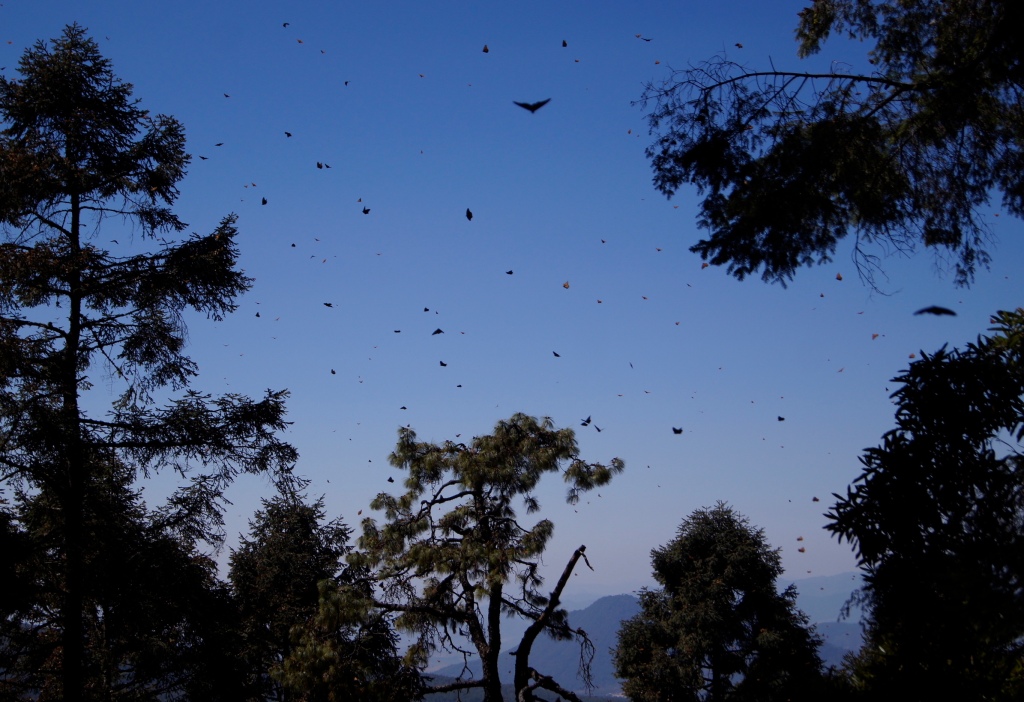
Sources and more information:
Michoacan travel website: https://visitmichoacan.com.mx/?project=mariposa-monarca
The Atlantic: https://www.theatlantic.com/science/archive/2015/12/monarch-butterflies-fly-south-for-the-winter/422115/
This page contains affiliate links, which means I earn a small commission if you purchase something after clicking a link on this site. I receive this commission at no additional cost to you.
12 Best Places in China to Visit
The amazing places in China are practically endless. China is a vast country with distinctive regions, culture, food, and even languages. You could travel for a lifetime and never run out of fun things to do in China.
For me, it hasn’t been nearly a lifetime, but I did live in China for three and a half years, from 2020-2023. (During the pandemic, yes, but that’s another story.)
I spent more than six months of that time traveling, and I was fortunate enough to explore many fascinating places in China.
Besides week-long stops in cities like Beijing and Hong Kong, I took three extended, multi-month trips: one in Yunnan Province, one in Sichuan Province, and another, my first, to a bunch of different destinations in China.
- The Best Places in China to Visit
- 1. Beijing
- 2. The Great Wall of China
- 3. Xian
- 4. Xingping (near Yangshuo)
- 5. Zhangjiajie
- 6. Hong Kong
- 7. Macau
- 8. Guangzhou
- 9. Kaiping
- 10. Shanghai
- 11. Yunnan
- 12. Sichuan
- How to Plan a Trip to China
- Where to Stay in China
- Best China Tours
- Suggested China Itineraries
The Best Places in China to Visit
With so many spectacular places in China to visit, it can be hard to decide where to go. Nature or culture? Big cities or small towns?
This list of the best places in China are my favorites from my 3 1/2 years of living and traveling in the country.
I visited all of these places in China myself. I walked the streets, got lost, and found cool things I’ve never seen in other articles online. All the photos in this article are mine.
I recommend some tours in China, which are a good option for saving time and avoiding hassles. Although all of these places in China can be experienced on your own, and traveling in China is mostly easy, taking a China tour can show you aspects of the country you may never see otherwise.
Because I lived in China during the pandemic, this list lacks some other popular places in China. Remote and exotic Tibet and Xinjiang were closed to foreigners the entire time I was living in China. Others, like Huangshan and Xiamen, I wanted to check out but never ended up getting to. Maybe some day.
If you have any questions about how to travel to China, see the sections at the end, or leave me a message in the comments.
1. Beijing
Beijing deserves all of its praise. The city is home to the richest repository of Han Chinese culture, China’s dominant ethnicity, which comprises 92% of the population.
Not merely the political and cultural center of the country, Beijing is also responsible for the common language. Potonghua, the standard language of China that’s used nationwide, is actually the Beijing dialect of Mandarin, brought to official status during the Republican Era of the early 20th century.
Beijing is a massive metropolis containing some of the most important historical sites in the country, but it never feels overwhelmingly big. Instead of crowded skyscrapers, the center of town is occupied by two mostly open-air attractions: Tiananmen Square and the Forbidden City, one of the largest palaces in the world.
- See the main Beijing attractions on this highly-rated and affordable private China walking tour: Tian’anmen Square and Forbidden City Walking Tour
Both are huge but quite spacious, and they’re surrounded by museums and walkable neighborhoods, with the modern central business district a short metro or Didi ride away.
Beijing is also renowned for its old neighborhoods based around alleyways called hutong. Although many got torn down in the previous decades, they’re still all over the city, including right next to the Forbidden City on several sides.
Some hutong are touristy, like Nanluoguxiang, and some are hip, like Wudaoying, but chances are there will be an everyday hutong located within walking distance of your hotel. With no souvenir shops or coffeehouses, just real-life residences, those hutong are really fun to stroll around — put away the smartphone and camera, and simply wander.
- A great way to experience the hutong of Beijing is on a China tour with a tuk tuk: Beijing Hutong Food and Beer Tour by Tuk Tuk
In case you’re wondering, Beijing and nearly everywhere else in China is extremely safe, with street muggings effectively nonexistent.
Finally, when talking about Beijing, you can’t forget the food. Not only do you have local cuisine, with Beijing duck and innumerable other dishes, but there’s also delicious food from all over China available in many different kinds of restaurants in Beijing.
The Great Wall passes by Beijing to the north, and several sections of the wall are within easy day-trip distance. When you visit Beijing, you’ll visit the Great Wall too.
2. The Great Wall of China
The Great Wall of China is more than a wall — it’s a wall passing through dramatic mountain scenery, sometimes hanging off the edge of cliffs.
It’s not enough to merely glimpse the wall rising and falling over this rugged scenery — you get to walk on it too. And if you’re not up for walking, you can take a cable car in the Badaling and Mutianyu sections of the wall.
In Chinese, the Great Wall of China is the Long Wall, a name recently adopted to cover the entire structure, which was previously known by many different names.
It’s not one contiguous structure at all, but a series of many walls. In some places in China, there are three different walls, all lined up in a row.
Therefore, there are many places in China to see the Great Wall. Most travelers go to one of the major restored parts near Beijing: Badaling, Mutianyu, Jinshanling and Simatai.
Years ago I went to Badaling, one of the most developed sections of the Great Wall of China. It was a nice experience, but when I returned I wanted to go to a less popular spot.
Before my last trip to Beijing, a friend recommended Huanghuacheng, which is often called the Water Wall. A large reservoir lies under the wall, and at several points the wall goes into it and under water. You can walk on the wall or on a trail along the reservoirs, and you may have it all to yourself.
We stayed the night before and after our day at the Great Wall in a nice guesthouse in the peaceful village outside the park. The wild, unrestored parts of Huanghuacheng are no longer accessible, but it’s still a great place to spend a full day exploring.
If you don’t have the time to spend several days getting to the Great Wall of China, you can save time and planning by taking a tour from Beijing. Here are some well-reviewed Great Wall tours. All you have to do is choose the section you prefer.
- Mutianyu Great Wall Bus Transfer with Options: Not a tour, but a hassle-free bus transfer taking you to one of the prettier parts of the wall.
- Private Mutianyu Great Wall Trip with English-Speaking Driver: Also takes you to Mutianyu, this time with private transportation.
- Private Great Wall Hiking Tour: Across The Border of 3 China Provinces: Hikers who visit China will want to check out this Great Wall tour, which includes a 3-4 hour hike at the Sanjiebei section of the Great Wall.
- Wild Great Wall Huanghuacheng Half Day Tour: This China tour from Beijing takes you to the section of wall I most recently visited. If you don’t have three days to spare going there on your own, then this is an excellent choice.
3. Xian
Located in north-central China, Xian (officially written as Xi’an) is best known for the Terracotta Warriors, a 2000+ year-old army of more than 8000 life-sized sculptures of soldiers, horses, and chariots. This monumental discovery was only made in 1974 and excavations are ongoing.
But there’s so much more to experience in Xian, a charming, easily-navigable mid-sized Chinese city. In 202 BC, Xian became the capital of the first dynasty of imperial China, and it’s played an important role in Chinese history and culture ever since.
Along with seeing the Terracotta Warriors, one of the best things to do in Xian is to walk the entire city wall. This 14-km trek through gates and past watchtowers gives sweeping views of the city, with dense traditional neighborhoods, leafy parks, large temple complexes, and remnants of the old city moat below.
Xian has some of the best food in China as well. The city has a large Muslim district, and in it you’ll find busy local restaurants serving local cuisine such as spicy noodles, lamb soup with pita crumbled in, and rojiamo, the Chinese hamburger.
- Explore this fascinating Xian neighborhood when you visit China on a Xi’an Muslim Quarter Night Market Foodie Walking Tour.
In Xian, come for the Terracotta Warriors, and stay for everything else. I spent over a week there and didn’t exhaust all the possibilities of what to do in Xian.
- Many China tours go to the Terracotta Warriors. This is the best one I could find: Customized Private Day Tour of Terracotta Warriors and Xi’an
4. Xingping (near Yangshuo)
China has some of the most striking mountain ranges imaginable, and the tall, rounded, steep karst mountains of Guangxi Province in southern China are some of the most iconic.
Guilin, the largest city in the area, is best known to the Chinese, while most foreigners think of the nearby town of Yangshuo first. Both are fantastic, although Yangshuo is probably a better choice for most international travelers.
The peaks in Yangshuo are denser and closer to town, and it’s also easier to get to the Yulong River, a stunning spot for a boat, bicycle, or motorbike ride through the mountains.
- Get to the best areas for cycling in Yangshuo without getting lost on this bicycle tour: Private Bike Tour: Yangshuo Countryside
Although it used to be this way, don’t expect a laid-back backpacker’s paradise in Yangshuo anymore: It’s now quite busy and firmly devoted to domestic Chinese tourism, though not nearly to the extent of Guilin.
Xingping, a small town on the Li River between Guilin and Yangshuo, is by far my favorite place in the area. It’s definitely touristy, but it’s also much smaller and is an ancient town full of historic buildings.
The view from the river in Xingping is so lovely that it’s even been featured on the RMB 20 bill.
If you like hiking, then Xingping is definitely your spot, with three good trails that go up into the mountains and a long walking path by the river. You also can hike or take a boat to Yucun, the next village over, and hear the story of how Bill Clinton and family dropped by in 1998.
In Xingping, it’s easy to get information about hikes in the area from any hotel. There are plenty of places to stay, including hostels with an international vibe (rare in China) and this really nice guesthouse, where I stayed for an extended visit in 2020.
Finally, another great thing about Xingping is how easy it is to get to. The Yangshuo high-speed railway station is right next to Xingping, while the town of Yangshuo is actually about an hour farther down the road.
- If you do go to Guilin, you can see all the sights on this China tour, which includes Reed Flute Cave, Xianggong Hill, and a Li River cruise: Guilin: Classic Private Full–Day Tour
I want to make a special mention of the Longji Rice Terraces, which are close to Guilin, in the opposite direction of Yangshuo. With slope after slope of rice terraces in every direction, they’re one of the most beautiful places in China I’ve seen. You can stay in a small guesthouse and hike all around them.
- If you don’t want to get hopelessly confused taking public transportation to Longji (like I did) when you travel in China, you can check out this Longji Rice Terraces & Minority Villages Private Day Tour
5. Zhangjiajie
Speaking of cool mountains, Zhangjiajie in the central province of Hunan should be at the top of every nature lover’s list of where to go in China.
Commonly known as Zhangjiajie (the name of the nearest city), Wulingyuan National Park has the kind of otherworldly, jaw-dropping scenery that could only exist in China.
Best known for valleys of tall, precariously-balanced stone pillars, Zhangjiajie also has dense jungle full of monkeys and giant salamanders.
The park has several cable cars and a super-high elevator, but it’s covered in trails too, making it great for hiking. The cable cars and elevator draw most of the tourists, so you may have the trails all to yourself.
The entry ticket for Zhangiajie is for three days, and you’ll need all three to fully appreciate the park. That’s how big it is.
In China and elsewhere in Asia (Angkor Wat for instance), multi-day tickets mean there’s enough in the park to justify spending each day there. Unless you’re really pressed for time, it would be a shame to only spend one day in Zhangjiajie.
Also, three days means insurance against bad weather. It was so cloudy on my first day in Zhangjiajie that I couldn’t see anything from the lookouts. I can’t imagine how disappointing it would have been to leave the following day.
Don’t limit your time to only three days, though. Down the road from Wulingyuan National Park, Tianmen Mountain is bulky mass of cliffs crossed by hiking trails and glass-bottom skywalks.
The name Tianmen, “Heaven’s Gate,” refers to a large natural arch with the 999-step Chinese Stairway to Heaven below. I suggest you walk down the stairs, not up them.
- You don’t need a tour for Zhangjiajie unless you’re pressed for time when you visit China. In that case, you’ll want to make the most of it. This China tour isn’t cheap, but it covers everything you need to see in Zhangjiajie (and includes all entrance tickets): Private Trip of Zhangjiajie National Park and Glass Bridge
6. Hong Kong
Hong Kong isn’t only one of the best cities in China, but one of the best cities in the world. Where else can you take a boat trip to an island, climb a mountain, eat first rate Cantonese food, and see a Black Sabbath cover band, all in the same day?
You must cross a border to go to mainland China from Hong Kong, and it has a different currency, but Hong Kong is officially part of China, which is why it’s on my list of best places in China to visit (along with Macau).
I can’t say enough good things about Hong Kong. Its multicultural vibe and wide variety of neighborhoods and landscapes make it unlike anywhere else in China.
And, making it even better, Hong Kong is a great place to look for international flights for flying to China. Coming from North America or Europe, you might find that a flight to Hong Kong is a lot cheaper than direct to a mainland city like Beijing or Shanghai.
As a worldwide tourist hub, Hong Kong has all kinds of interesting tours available. Here are some of the cooler Hong Kong tours I found:
- Enjoy a light show from Victoria Harbour on the Victoria Harbour Night or Symphony of Lights Cruise
- Experience the best of Hong Kong — sightseeing, food, history — with this popular Hong Kong Tour – Landmarks Visit
- Looking for something different from a Hong Kong tour? Check out this Dark Side of Hong Kong Walking Tour
7. Macau
Macau is close to Hong Kong, just across the Pearl River Estuary, and it has a similar colonial history. But it’s a mistake to assume these two cities are anything alike.
For one, Macau is much smaller. Confined to two smallish islands, which were once several more until extensive land reclamation projects combined them, Macau is easy to navigate and get around.
Until you begin exploring the Historic Centre of Macau, that is. Macau’s old downtown core is a maze of twisting streets and narrow alleyways, somehow all leading to the hilltop Ruins of Saint Paul’s, the facade of a 17th-century church which includes Chinese characters, guardian lions, and other Asian touches.
Most of the buildings in central Macau are mid-century Chinese-style apartment buildings with decaying metal-bar “pigeon cage” porches built impossibly close to one another. But then, you turn a corner and suddenly see a stately old building from the colonial Portuguese days.
All this means that Macau is great for walking, and when you get tired of the urban labyrinth, you can head out to Taipa and Coloane on the larger southern island for charming fishing villages, nice hiking trails and a few sandy beaches.
And don’t forget the casinos. Built on a flat expanse of reclaimed land, these huge structures rival Las Vegas in size and audacity (gondolas on a system of indoor canals in the Venetian, a full-size Big Ben outside the Londoner, etc.)
It’s Vegas without the party, though, and 90% of the tables are baccarat, with very few for blackjack, poker, or roulette. Table minimums are really high, too. Therefore, most ordinary tourists will probably prefer Macau’s less risky delights.
- It’s easy to visit Macau from Hong Kong, and if you want to maximize your time and minimize your planning, you can do so on this One-Day Macau City Tour from Hong Kong
8. Guangzhou
As much as I love historic Beijing and dynamic Hong Kong, Guangzhou is my favorite city in China.
Guangzhou is Canton, so it’s ground zero for all things Cantonese: culture, language, and of course food.
I lived in Guangzhou for six months and spent a lot of time exploring the city. It’s a sprawling megalopolis home to many unique neighborhoods, all very walkable.
Three large neighborhoods are chief among them: ultra-modern Tianhe, bustling central Yuexiu, and well-restored, traditional Liwan.
It takes at least a day to properly see each, meaning Guangzhou is three (or more) cities in one. Add in all the other surrounding attractions, and you could easily spend a week in Guangzhou and have plenty left for your next visit.
- A night cruise on the Pearl River is one of the top things to do in Guangzhou. Book it here with this Guangzhou tour: Pearl River Night Cruise with Private Transfers in Guangzhou
Guangzhou has a good location too, about an hour (by subway and high-speed train) from Shenzhen, which in turn is on the border with Hong Kong. City lovers could make an excellent China trip of exploring Hong Kong, Shenzhen, and Guangzhou in a week or longer.
Actually, if you can stand to miss the top attractions in China — Beijing, the Terracotta Warriors, and the panda reserves — an excellent alternative itinerary for hitting some of the best places in China would be to take the high-speed train from Hong Kong to Guangzhou and then onward to Xingping (Yangshuo), #3 on this list of places in China to visit.
And while in Guangzhou, if you have time, take a side trip to…
9. Kaiping
About an hour south of Guangzhou is Kaiping, one of the lesser-known places in China to visit.
The top Kaiping attraction is the Diaolou, early 20th-century homes built by returning overseas Chinese. Most are blocky, fortified towers with beautiful ornamentation inside and out.
The history of how these came to be is too complicated to get into here, but know that visiting the Kaiping Diaolou involves learning a lot about the interesting, turbulent history of modern China.
Thanks to a free bus connecting several villages of Diaolou in the suburbs of Kaiping, visiting them is easy. And because most Diaolou are still functioning residences, and many are adjacent to ancient rural villages, this trip also serves as a glimpse into life in rural China. (There’s no website for the bus — just show up at one of the villages and you’ll find it.)
Kaiping itself is a small-sized everyday Chinese city, but to me, that’s part of its appeal. It’s a prosaic and gritty view of the country you’d never get if you confined your China trip to only Hong Kong or Guangzhou.
For a cinematic look at the Kaiping Diaolou, check out the excellent and supremely-popular Chinese action/comedy/Western Let the Bullets Fly, which was filmed in the area.
- Don’t have three days to experience Kaiping while you visit China? You can get there and back in one day with this well-reviewed China tour from Guangzhou: Kaiping Private Day Tour From Guangzhou
10. Shanghai
China’s second city doesn’t quite have the concentration of history and culture that Beijing has, but Shanghai is undoubtably an excellent destination in its own right.
Although it’s second to Beijing in terms of cultural, political, and historical significance, Shanghai is China’s largest city — by a lot. At about 22 million, its population is nearly twice that of Beijing, the second most populous in the country.
Central Shanghai is cut in half by the wide Huangpu River. One side has the Bund, an elevated path along the river, with large colonial era buildings behind it. Behind the Bund are broad shopping streets and block after block of the singular Shanghai-style shikumen communal housing.
Farther on are other novel Shanghai neighborhoods to wander around, such as the faithfully-recreated old-China pedestrian streets surrounding Yu Garden and the historic French Concession.
- Visit all the best Shanghai neighborhoods on this Shanghai: 8-Hour Private City Tour
- More into food than sightseeing? When you travel to China, this Shanghai tour is for you: Shanghai: 3-Hour Local Food Tasting Tour
- Another great option is to explore Shanghai by bicycle: Shanghai Half-Day Bicycle City Tour
The other side of the Huangpu contains the structures of Shanghai’s instantly-recognizable skyline, including the Oriental Pearl Tower and the Shanghai Tower, the third tallest building in the world. Naturally both have an observation deck for you to ascend.
Getting out of the city center is also rewarding in Shanghai. Yes, there’s Shanghai Disneyland, but there are also numerous water towns to choose from as well.
Water towns are old communities built around canals, and there are more than a dozen noteworthy ones around Shanghai.
A great choice for a day trip from Shanghai is Suzhou, which besides the canals and narrow alleyways of a water town is home to some of the most famous classical gardens in all of China.
- See Suzhou and a water town on this popular day trip from Shanghai: Su Zhou and Zhou Zhuang Water Village Day Tour
11. Yunnan
For my final two best places to go in China, I’m putting in whole provinces.
I spent about six weeks each in Yunnan and Sichuan on separate trips. If you’re looking for some real adventure in China and have longer than a month to travel, I suggest flying into a major city and then heading right to one of these provinces.
Located at the eastern edge of the Tibetan Plateau, Yunnan and Sichuan are so jam-packed with natural beauty and history — sometimes both in one destination — that I’d quadruple the length of this article if I included them individually.
So, instead, I’ll list some of the top destinations in Yunnan and Sichuan to explore when you travel to China. Some of the best places to visit in Yunnan are:
- Kunming: On the shore of a large lake, the capital of Yunnan Province has historic neighborhoods and a fantastic mountainous area, Xishan, with trails and temples carved into cliffs.
- Shilin (Stone Forest): Near Kunming is this bizarre landscape unlike anywhere else in China, although similar landforms do exist in other parts of the world. Many people see it on a day trip from Kunming, but you could stay a night or two in order to have more time in the park and surrounding areas.
- Dali: It’s a beautiful ancient town next to a big lake with a tall snowy mountain backdrop behind. There are great hikes in the mountains and nice walks along the lake.
- Lijiang: Possibly the prettiest and most interesting ancient town in China, Lijiang is a maze of winding cobblestone streets and well-restored courtyard houses.
- Tiger Leaping Gorge: Near Lijiang, the Tiger Leaping Gorge is where the Jinsha River runs behind the Jade Dragon Snow Mountain. The best way to experience it is with a two-day hike on the upper trail.
- Shangri-La: A few hours north of Lijiang and Tiger Leaping Gorge is the town of Shangri-La. The old Tibetan town was mostly destroyed by a fire is 2014, but it’s been so tastefully restored that you’ll never notice. Some buildings were spared by the fire, including this traditional guesthouse, one of my favorite places to stay in China. While in Shangri-La, don’t miss the massive Ganden Sumtsenling Monastery, the closest you’ll get to the Potala Palace if you can’t make it to actual Tibet.
- Xishuangbanna: Near the Laos and Myanmar borders, Xishuangbanna is Southeast Asia with Chinese characteristics. In town, enjoy the expansive night market; outside of town, choose from a hilltop Buddhist temple, big botanical gardens, and a wild elephant sanctuary.
There’s a lot more to see in the province; these are the major destinations in Yunnan. As I mentioned, check back on this blog for a complete article about travel in Yunnan.
12. Sichuan
Yunnan and Sichuan both have incredible natural areas and lots of culture.
I spent about six weeks traveling in each, and I got the impression that Yunnan is much more traveled by international visitors than Sichuan. There was far less English spoken (and written) in Sichuan, and my wife and I were stared and pointed at by locals more often in Sichuan than in Yunnan.
Traveling in Sichuan was a little more challenging, but as with all places in China, it’s not really that difficult.
Some of the best places in Sichuan are:
- Chengdu: Sichuan’s capital city has well-restored ancient towns, busy city-center outdoor shopping districts, world-class museums, and some of the best food in China. And don’t miss the fabulous Sichuan Opera.
- Panda reserves: Start with the Chengdu Research Base of Giant Panda Breeding, which has hundreds of giant pandas and red pandas. Then, venture into the countryside for other reserves, such as the Dujiangyan Panda Base, called Panda Paradise in Chinese.
- Dujiangyan: It’s a large, charming ancient town next to one of the world’s oldest irrigation systems. Close by are two excellent hikes on Qingchen and Qingchen Hou mountains.
- Siguniangshan: In cultural Tibet, you can hike to the foot of 6,250-meter (20,000-foot) Mount Siguniang or though the forest valley below.
- Jiuzhaigou National Park: This is one of the most beautiful national parks in China, and not for the mountains (which are pretty), but for the multicolored lakes and terraced waterfalls between them. One day is not enough to fully take in Jiuzhaigou.
- Leshan: Surrounded by ancient temples, the 233-foot, 6th-century Leshan Giant Buddha gazes over a lazy river from his cliffside seat.
- Emeishan: You have many hikes to choose from on this large sacred mountain, including a two-day trek from the bottom to the top, staying the night in a Buddhist temple on the way.
- Bamboo seas: There are several large bamboo forests in Sichuan province. I visited one right outside of Chongqing called Tea Mountain, named for the tea plantations outside the bamboo.
Chongqing isn’t part of Sichuan Province anymore, though it used to be, and it’s easy to get to by high-speed train from Chengdu.
Built over the high banks of the confluence of the Yangtze and Jialing rivers, Chongqing is part ordinary Chinese big city and part city from a parallel universe, where subway trains pass through apartment buildings and timeworn caves converted to tourist complexes resemble the bathhouse in Spirited Away.
Simply put, yes, Chongqing is worth a stop when you visit China.
Please check back on this blog for a complete article about traveling in Sichuan.
How to Plan a Trip to China
After you’ve considered the many places that you’d like to visit, the next step is to make a definite plan to travel to China.
First, think about flying to China. I suggest looking for international flights to Beijing, Shanghai, and Hong Kong. Check the prices and connections. You may want to fly into one city and out of another.
From those cities, you can fly to anywhere else in China. You can also take the train to just about anywhere as well, but if it’s far away, flying might be cheaper. Check both as you plan your China trip.
One of the best resources for finding flights (and hotels, trains, and more) in China is trip.com. You can also fly to China by checking booking.com.
You can use trip.com for trains in China, but they charge a small fee, which will add up if you’re doing a lot of train travel.
The Chinese website for buying train tickets directly is 12306.cn. After your first purchase, you’ll have to go to a station ticket counter to confirm your identity, although there’s talk of this requirement being taken away. If this is too complicated, then just use trip.com for train travel in China.
Also necessary for traveling in China is the app Didi, the Chinese Uber.
Planes, trains and Didi: That’s about it. Unless you take a tour or go somewhere remote, you may never get on a bus in China.
Where to Stay in China
In my experience, the two best websites for finding hotels in China are trip.com and booking.com.
When I’m looking for hotels in China, I always check both. I find that trip.com usually has better options for China — it’s a Hong Kong company, after all — but sometimes I encounter a better deal on booking.
If you’re overwhelmed by all the accommodation options, you can rely on a few common hotel chains in China that are almost always cheap and clean. In multiple cities I’ve stayed in Lavande, Ibis, Campanile, and Holiday Inn Express and have never been let down.
Outside of major cities, some major higher-end chains, like Hyatt, might be surprisingly affordable, so check them too.
Note that hotels in China need special permission from the government to accept foreigners, and often the very cheapest hotels don’t have that permission. If you’re using trip.com or booking.com, don’t worry about it, because those apps won’t let you make the reservation as a foreigner anyway.
There aren’t many hostels in China, although you might find them in major cities. Airbnb does have a presence in China and is worth looking at for certain areas. If you can’t find a hotel you like, check airbnb.
Best China Tours
I don’t recommend you sign up for a tour for your whole time in China. Tour groups in China are notoriously large, noisy and rushed. They include very little free time and only go to the most popular destinations. It wouldn’t be fun to be stuck in one of these groups for your entire China vacation in a country that, despite some difficulties, is generally easy to travel in.
There are, however, two very good reasons to take a China tour: to save time and to avoid confusion. Also, tours in China can be very affordable and will almost always save you money.
I say, if you want to take a tour in China, take a day tour. The ones I recommend in this article all have good reviews and go to cool places.
Here are some of the more interesting China tours I found:
- Hike the Great Wall of China on this Private Great Wall Hiking Tour: Across The Border of 3 China Provinces
- See two of the top attractions in Sichuan on the Chengdu: Giant Panda Research Base & Leshan Buddha Day Tour
- Get up close with the pandas on this Dujiangyan Panda Volunteering Experience with Lunch
- Kunming: Stone Forest Private Day Tour: Get to the Stone Forest and back from Kunming easily on this Yunnan tour.
- This Jiuzhaigou tour is expensive, no doubt about it, but if you want to see what may be the most beautiful natural area in China (and Huanglong National Park too) in the most efficient and stress-free way possible, then check out this Private 4-Day Jiuzhaigou and Huanglong National Parks Tour from Chengdu
- 7 Days Lhasa to Kathmandu Overland Small Group Tour: This China tour gives you the complete Tibet experience in only one week.
Suggested China Itineraries
You’d need a minimum of six months to properly see every place on this list of best places in China. Assuming you have less time than that, at least a week and up to a month, I’ve created some possible itineraries for your China trip.
Because of the ease and relative low cost of air travel in China, you can really make any plan you want. You can fly to China and then fly to three or four different places in China in far away parts of the country for very reasonable prices.
If you’d like to keep things simple (and cheap) by visiting destinations in China that are close to each other, here are my suggestions:
- Best of China: Beijing and the Great Wall (1 week). With extra time, you could add a trip to Xian or Shanghai (2-3 weeks).
- Best of Southern China: Hong Kong and Guangzhou (1-2 weeks). With extra time (2-3 weeks), stop in Shenzhen on the way between them, and take in some beautiful natural areas using the high-speed train from Guangzhou north to Xingping and Yangshuo or south to Kaiping, Zhuhai and Macau.
- Mad Mountains in China: If you really love nature but only have about two weeks, this one’s for you. Travel to Zhangjiajie (1 week: 3 days for the park, plus a day in Tianmen Mountain and travel time between them) and Xingping/Yangshou (minimum 1 week). If you have a little more time, you can start and end your China vacation in a big city like Beijing or Hong Kong.
- Yunnan Adventure: Visit some or all of the places in Yunnan I listed above. You’ll need a month or longer to see them all. It took me six weeks.
- Sichuan Adventure: Like for Yunnan, look at the places in Sichuan and choose your favorites, basing your trip in Chengdu. This trip is a little harder than in Yunnan, since the destinations are more scattered about and it’s somewhat less traveled by foreigners than Yunnan.
Thanks for reading this article about my favorite places in China. Any questions, please write in the comments below, and check back for future articles that will go more in-depth about some of these wonderful places in China.
This page contains affiliate links, which means I earn a small commission if you purchase something after clicking a link on this site. I receive this commission at no additional cost to you.
Mexico Songs by Gringos
I love Mexican music and could go on and on about my favorite groups and songs. In fact I wrote about some of them in this article.
There are also plenty of cool songs about Mexico by foreigners, mostly Americans.
Sometimes they’re dreamy glimpses of Mexico in the imagination, like James Taylor’s Mexico.
Sometimes they’re stories of bandits and federales, like Pancho and Lefty, by Townes Van Zandt, made famous by Willie Nelson and Merle Haggard.
Sometimes they use the trope of Mexico as an escape, like Mexico by Cake, but they’re good songs about Mexico anyway.
The bad songs about Mexico, which aren’t on my list, are about doing tequila shots and making stupid decisions. Honestly, I don’t mind the lyrical content—I like doing tequila shots and making stupid decisions—but the music accompanying these banal, cliched songs about Mexico is undeniably terrible.
Instead, I want to hear (and recommend) Going Down to Mexico by ZZ Top, Mexican Minutes by Brooks & Dunn, The Seashores of Old Mexico by George Strait, Buenas Tardes Amigo by Ween, Mexicali Blues by the Grateful Dead, and South of the Border, a jazz standard done very well by Frank Sinatra, Patsy Cline, Willie Nelson, and numerous other artists.
All of these songs about Mexico and more are on my Youtube playlist Mexico Songs by Gringos. Check it out, and please recommend what I missed.
